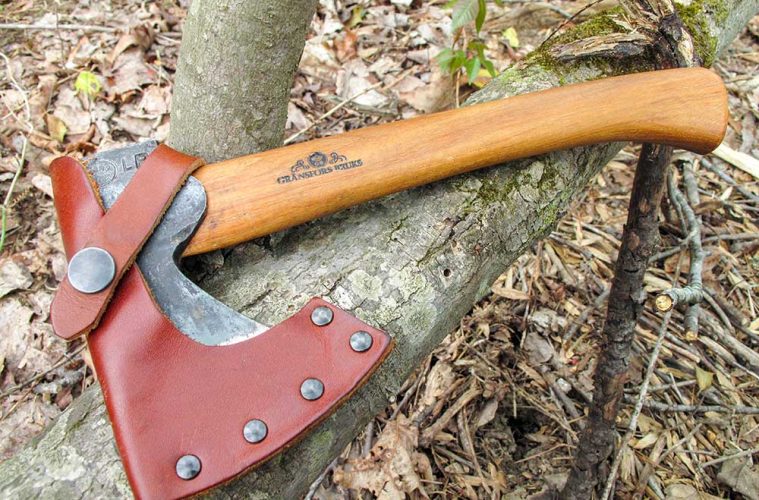IT’S A HATCHET, A KNIFE—IT’S A SUPER TOOL!
After a week in the woods of Alabama followed by a week in South America with the Gränsfors Bruk Mini Belt Hatchet, seeing is believing! I finally got a chance to try out a good quality belt hatchet from what some people consider to be the best company out there for axes and hatchets. Gränsfors Bruk, founded in 1902, currently has 30 employees who manufacture and sell axes, with 80% of those axes being exported to 22 countries.
After doing my research, I found much information on Gränsfors Bruk. The roots of Gränsfors Mini Belt Hatchet go back many thousands of years. In the old days in Europe, it was common to carry a belt axe that could be used as a knife and an axe—a valuable tool and a weapon.
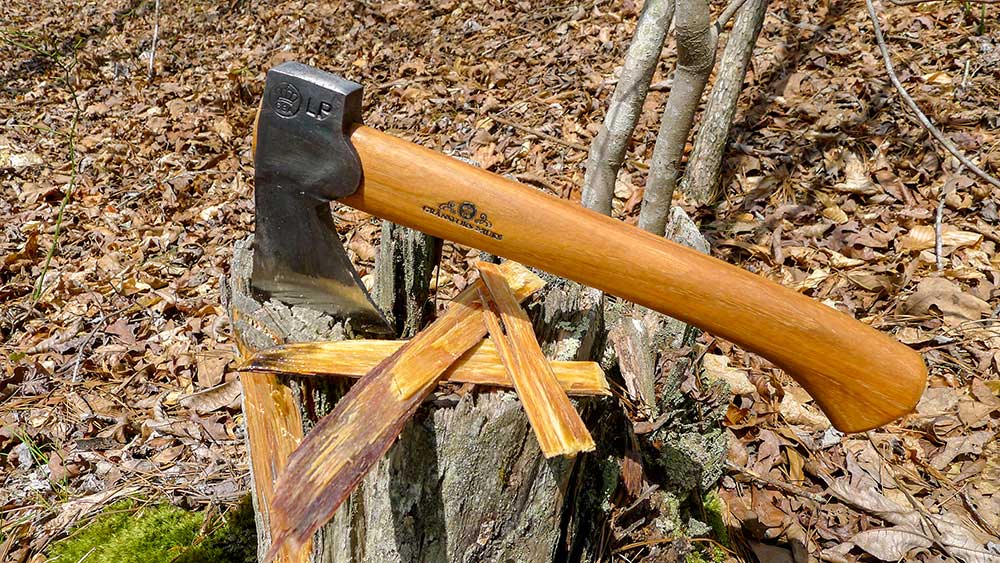
When harvesting fatwood, nothing gets chunks out of the stumps faster than a small hatchet. A hatchet will do most of the chores for the grunt work without ever using your sheath knife, thus saving your knife edge for the delicate tasks.
A nice belt axe was also a symbol of status. In the 16th and 17th centuries, the French began trading axes with the American Indians. The small belt axe, light and narrow, became the “trade axe” and was transformed into the tomahawk.
But Gränsfors Bruk Mini Belt Hatchet is neither a tomahawk nor a scaled-down axe. It is a functional design by Lennart Pettersson (LP) at Gränsfors Bruk in Sweden. Lennart, an axe smith, knifesmith, backpacker, and fisherman, has created a little hatchet that can be used as an axe and a knife.
This little hatchet is hand-forged of high-carbon Swedish steel and tempered at the bit to a hardness of 57 Rockwell C. It has a 2½-inch cutting edge, a 10-inch hickory handle, and weighs only 12 ounces. The hatchet comes with a grain-leather sheath.
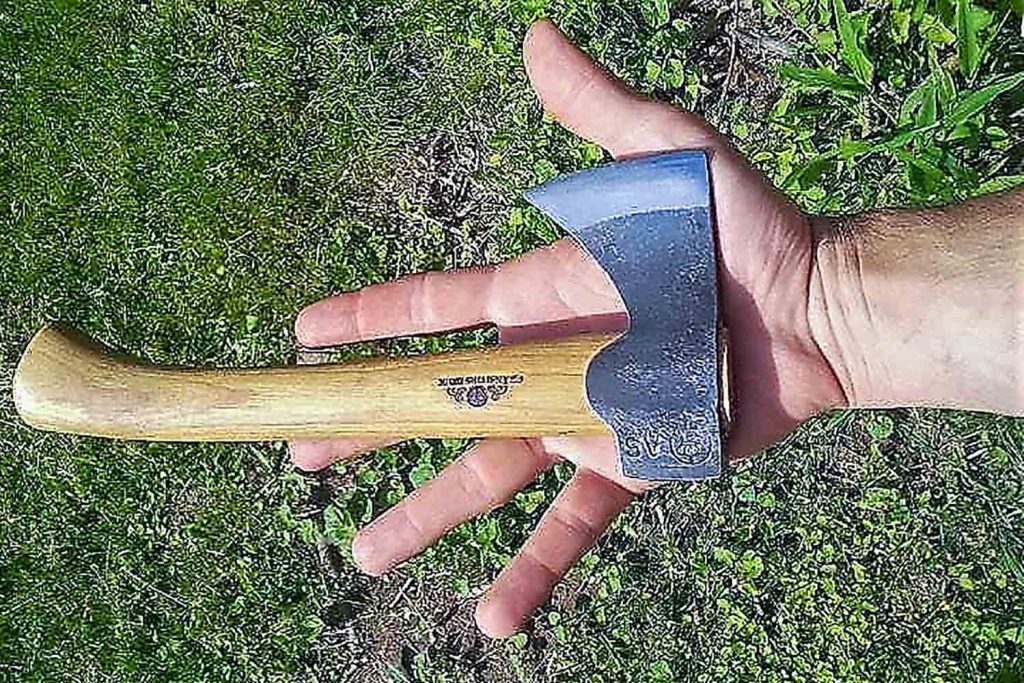
Gränsfors Bruk Mini Belt Hatchet is 10 inches long overall, with a sub-3-inch blade. Hand-forged from high-carbon Swedish steel and tempered at the bit to a hardness of 57 Rockwell C.
SURVIVAL TOOL EXTRAORDINAIRE
I have heard of the effectiveness of an axe in the woods all my life. However, up into my early 30s, I have never owned one. This is due to the part of the United States where I grew up, Southern California. In recent years, California has been hit with an infestation of Bark Beetle (Western Pine Beetle), which aggressively attacks and kills ponderosa and Coulter pine trees of all ages. This means there are fallen trees and chunks of wood everywhere, thus eliminating the need for a lot of wood chopping.
“As a stand-alone wilderness tool, this hatchet undeniably has the potential to get your camp made and assist in self-rescue…”
I took a week-long trip to Alabama to assist with a Randall’s Adventure & Training survival class. During that week, I had the chance to check out team leader Jeff Randall’s Gränsfors Bruk Mini Belt Hatchet. What caught my eye was the small, compact size of the tool and the “what are you doing here” type of feeling I had towards it. After all, this was machete and big knife country. Upon further investigation, I had a chance to test, evaluate, and experience myself what all the craze was about.
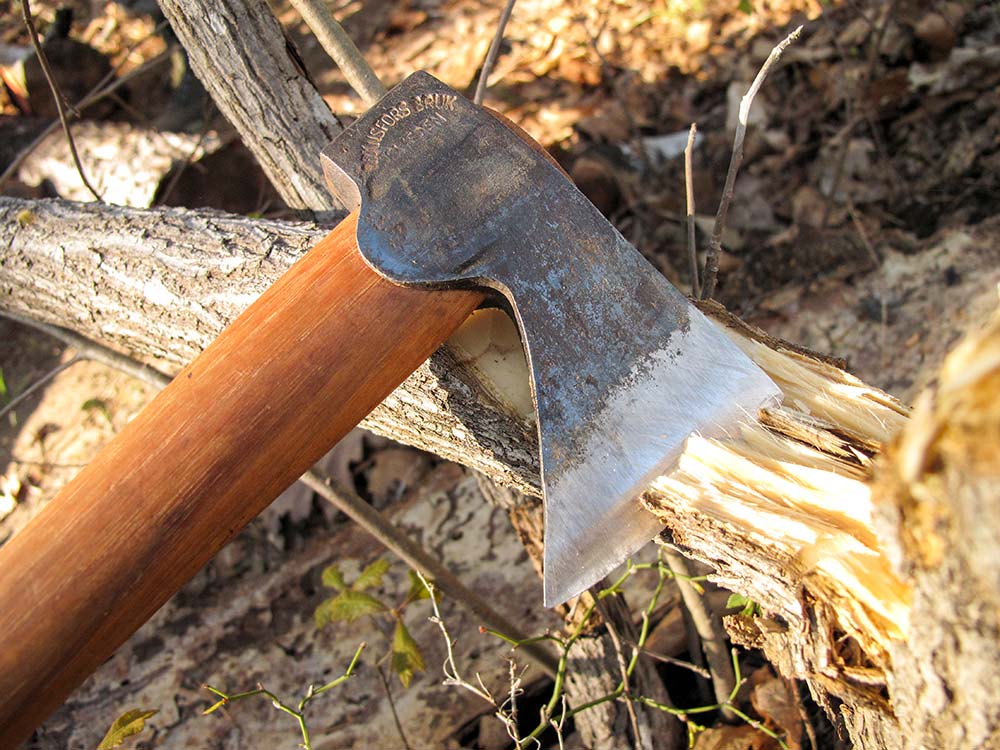
Chopping poplar and dogwood with the Gränsfors Bruk Mini Belt Hatchet was easily done for making fire and shelter poles.
I first went to some standing deadwood and chopped down poplar and dogwood. I was surprised at how efficient the cutting edge was as it sunk deep into anything at which I swung. Splits on a downed log also demonstrated its ability to get inside the dry wood without using a baton stick (like a person would do with a knife).
In addition to using it as a chopping and splitting tool, the hatchet can be held farther up the handle towards the head (heel) and used for more controlled, short, precise chops. On a hatchet this size, one-handed chops were easy and better suited to the design of the Mini Belt Hatchet.
By holding the axe head with the palm of the hand and cupping the hammer portion (butt), I could use the tool as a small knife and create some beautiful feather sticks. This is a task usually performed with a knife. The convex edge and small size made this task not only easy, but it outperformed some of the knives on the trip in the woodcraft department.
In all fairness to the knife, there is not a defined point for incising on a hatchet, so a small knife is a perfect companion to a hatchet and axe.
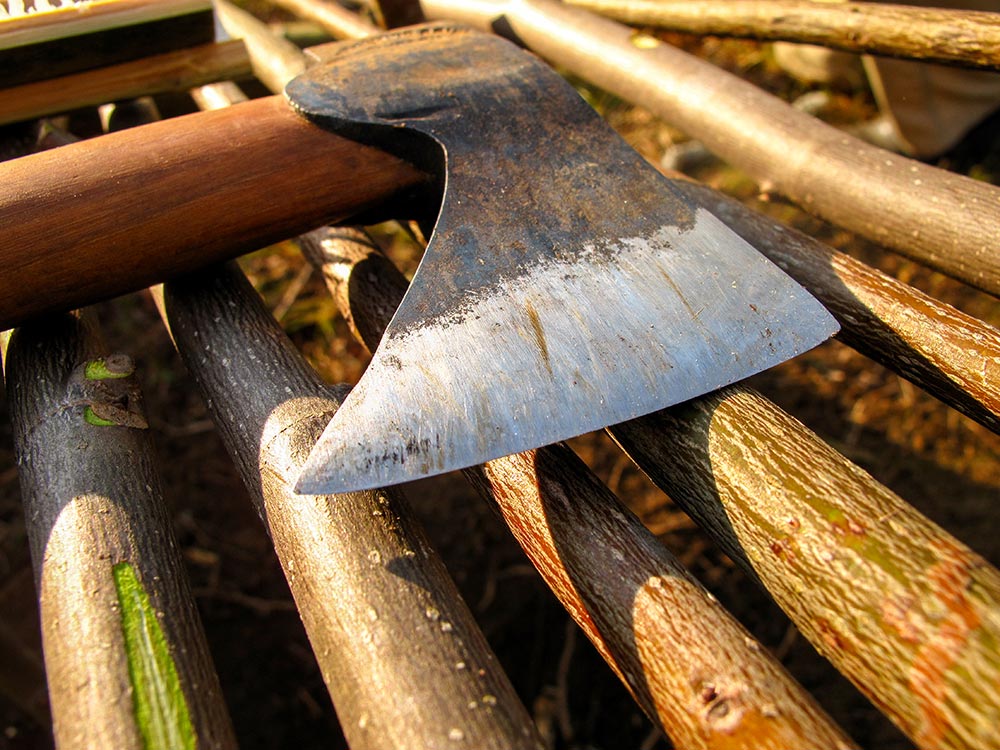
The gentle convex of the Gränsfors Bruk Mini Belt Hatchet was flawless. The author easily achieved knife-like qualities.
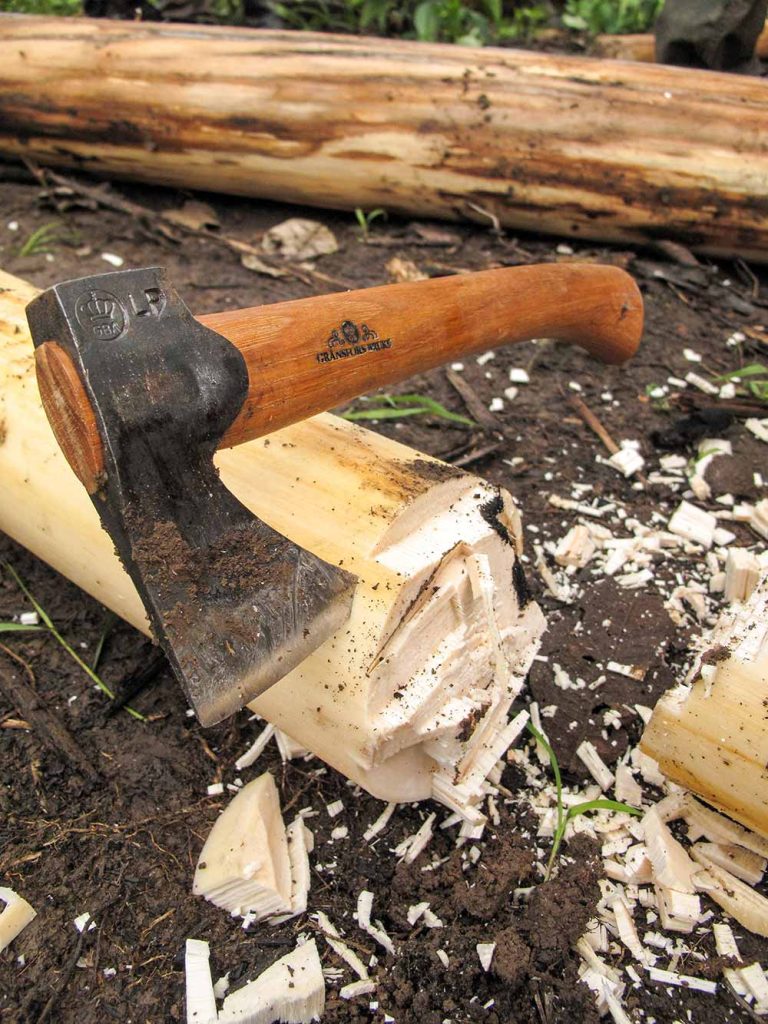
Gränsfors Bruk Mini Belt Hatchet with its convex grind made cutting through this balsa log an easy task in just under a minute.
WAY DOWN SOUTH
Less than a month later, I flew down to South America for some jungle survival. I’m sure most people think of the jungle terrain and picture a long, thin-bladed machete hacking through the rain forest and being used for everything—well, it’s true. The one-tool-do-all, the machete, is just that.
“By holding the axe head with the palm of the hand and cupping the hammer portion (butt), I could use the tool as a small knife…”
However, there were a few applications where the use of a hatchet truly came to light. One of the most important aspects of jungle survival is the ability to self-rescue.
That’s right, getting to the water and following it down to the larger rivers where there are likely to be fishermen or small villages. There are two ways to do this: hike along the water’s edge, which is not very easy at all, or float.
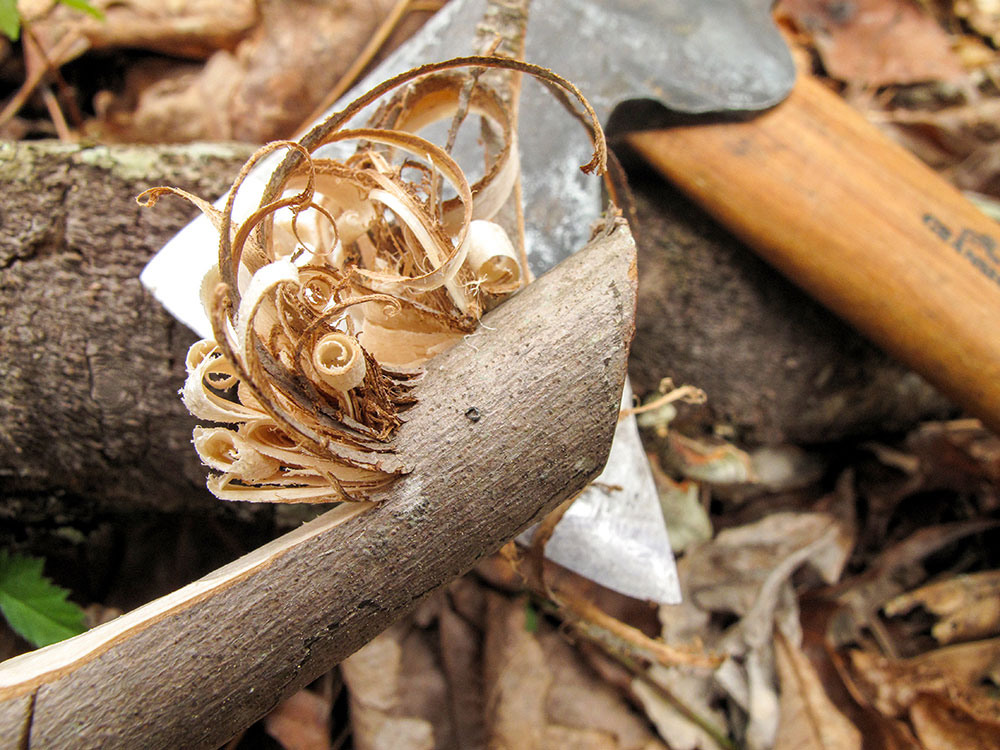
Used as a knife, the Gränsfors Bruk Mini Belt Hatchet outperformed the dedicated knives most of us had in camp. A one-tool-do-all candidate, in my opinion.
During the construction of small one-man rafts, the students all used machetes and large knives to section off pieces of balsa trees. “Balsa” is the Spanish word for raft and is aptly named.
When a group leaves camp on an established trail, not everyone needs to take a machete; a few will do. When it came time to chop the balsa trees down to size, a few were waiting their turn to use a machete; this is when the mini hatchet came out.
I will never forget the look in the eyes of our Peruvian guides when they saw that thing. I knew they couldn’t wait to try it out, so I gladly handed it over for them to try after I sectioned one piece.
Balsa wood is soft and light, making it ideal for raft construction. The light weight and short reach of the mini hatchet were just enough for chopping through 6- to 8-inch pieces of wood.
I found this hatchet has a way of making more controlled, precise chops than a long-bladed machete, which made it ideal for the next step. A 2-inch notch must be cut around the circumference of the logs for attaching cordage, which will join both pieces together.
Again, short quick blows were easily delivered with the tool and in a shorter amount of time, cutting down on fatigue that only accumulates during jungle living.
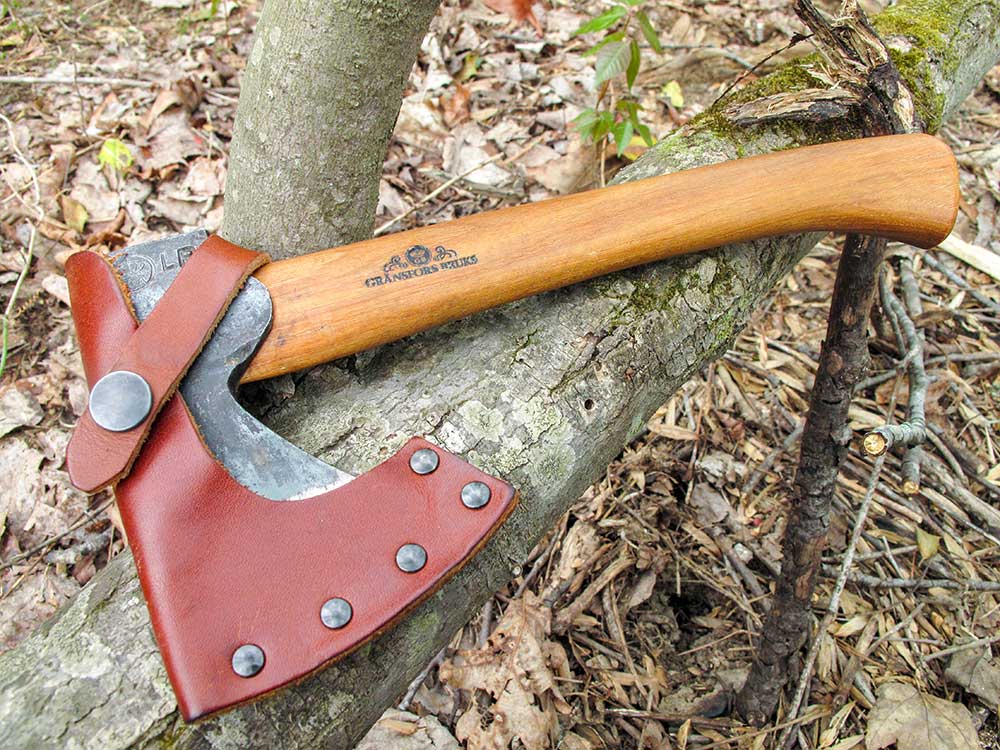
A simple leather sheath with a positive snap closure enables easy transportation.
A HARD-USE TOOL
Gränsfors manufactures axes for various uses, including wood chopping, crafts, carpentry, hunting, and axe throwing. As a stand-alone wilderness tool, this hatchet undeniably has the potential to get your camp made and assist in self-rescue if you need to take to the water. I would have to say that the Gränsfors Bruk Mini Belt Hatchet is a definite hard-use all-terrain survival tool that should not be overlooked. KI
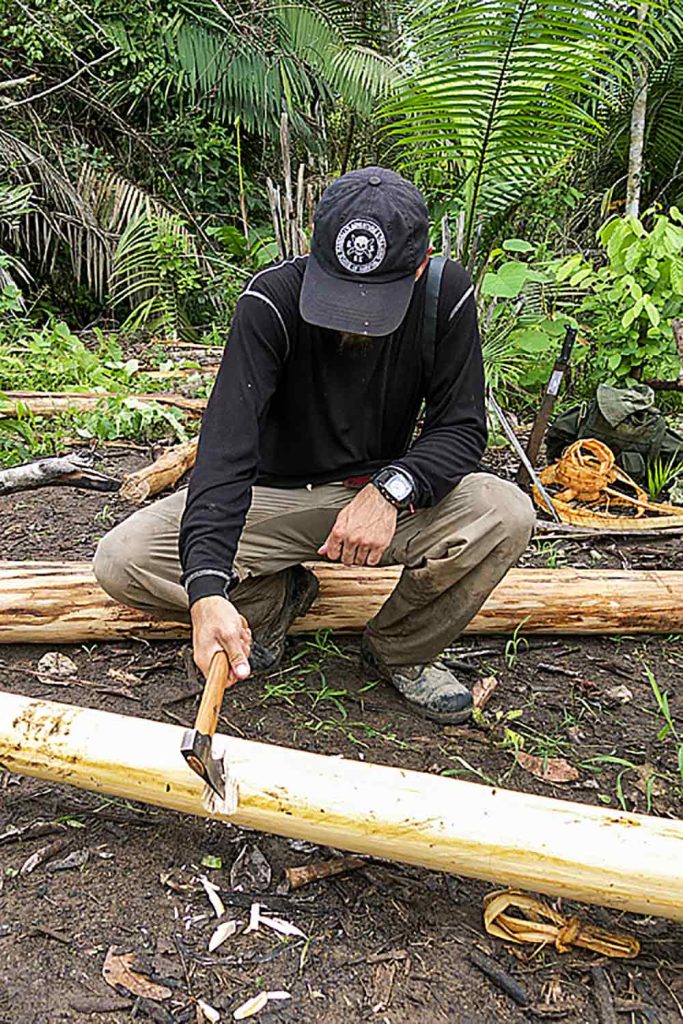
Author using the hatchet in Peru to section off a piece of balsa log for rafts. Gripping the handle as far back as possible makes for easily controlled blows.
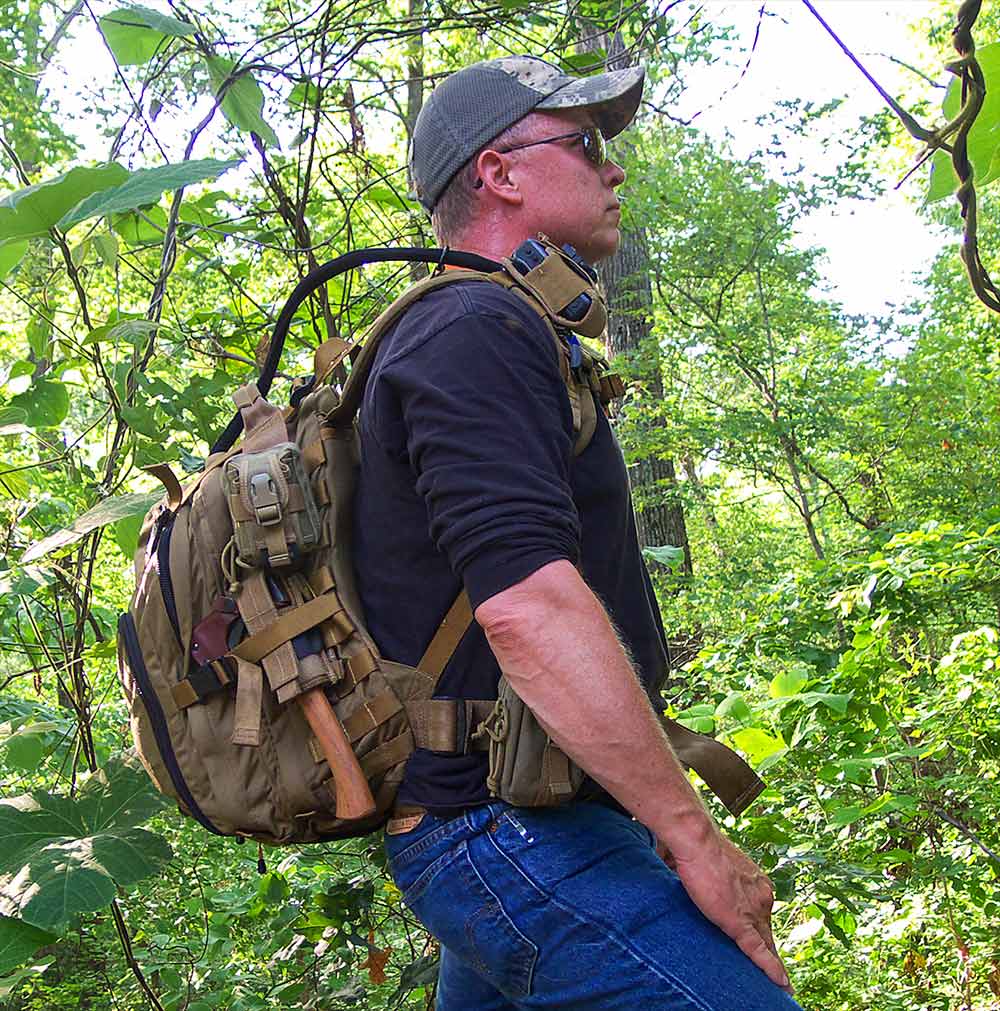
Team leader Jeff Randall carried the Gränsfors Bruk Mini Belt Hatchet on his pack while trekking through the woods. The slim carry and overall packability are why it is always on hand.
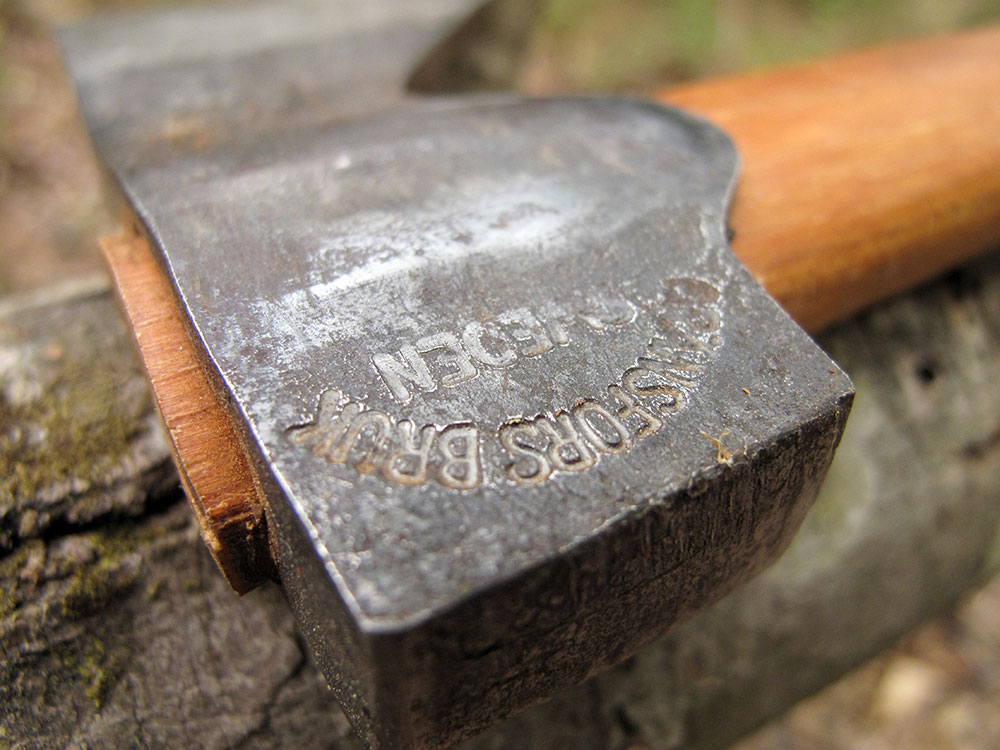
When it comes to hammering in stakes and knocking dry branches off a dead tree, the hammer poll is first on call. The author stuck with light hammering duties such as stakes made from deadwood and softer greenwood.
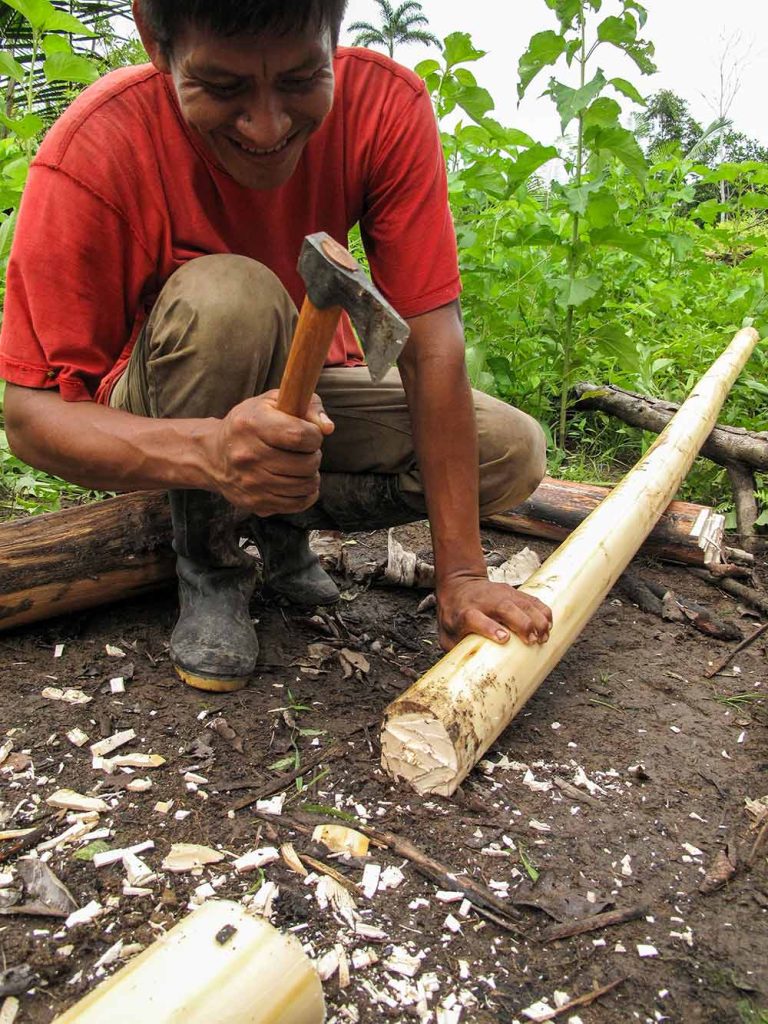
The Gränsfors Bruk Mini Belt Hatchet was a favorite among the students and local guides. It was a refreshing change in cutting tools from the machete, making the hatchet shine when making notches around the log for attaching cordage.
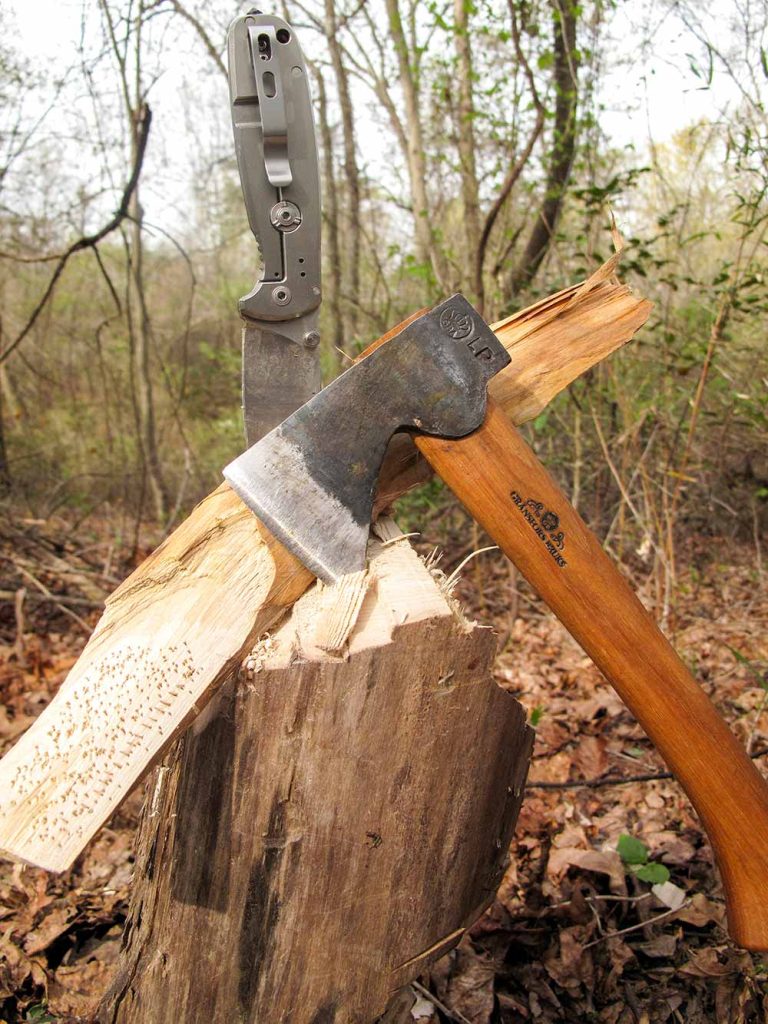
Chopping a small tree was a little out of the punching range for this Gränsfors Bruk Mini Belt Hatchet, yet it prevailed. Combined with a good folding knife, much was possible for the author.
HATCHET VS. KNIFE
Which is the better survival tool? There can be no definitive answer to this question. Any one person is likely to answer the same question differently depending on the situation in which they find themselves. The knife may be better suited to many tasks, but the hatchet can adequately perform some of them—while performing others that are impossible with a knife.
In any survival scenario, you need to choose your tools based on your environment, likely tasks, and obstacles you may face. Ideally, you should have both tools, and if you have a couple of people, you can split the job of carrying these items and have the best of both worlds. If not, you may have to make a choice.
But I can’t make it for you. Heck, if you live in the tropics, you might dump both of these in favor of a machete! The lesson is simple: adapt to the circumstances. That’s how you survive.
CHOPPING TOOL SAFETY CONSIDERATIONS
There are no minor injuries when it comes to the axe type of tool or any chopping tools. Chopping requires a lot more energy to use over a saw; therefore, it is more dangerous. An axe, hatchet, tomahawk, and machete can be “stand-alone tools” but really shine when it comes to splitting and hacking.
The impact of these types of tools can be devastating to a limb or body part. Be aware of the follow-through and direction of the cutting edge at all times. Like machetes, hatchets are dangerous due to their short handles, which can often injure a knee or shin on the follow-through or glancing blow.
The longer handles of a half or full axe and some tomahawks will be safer in that the cutting bit will be more likely to dig into the ground rather than come back towards you.
Unlike a saw, never chop above your head; keep the work as close to the ground as possible. It is always safer with a hatchet or short-handled tomahawk to kneel down with the work in front of you.
Sunglasses or safety glasses will keep your eyes safe from sharp chips that will undoubtedly be airborne when chopping. When splitting or chopping, always keep a safe, parallel plane to the ground or wooden stump. If at all possible, don’t use heavy cutting tools after dark. When a person feels weak and fatigued, that is the best time to stop chopping, as a shorter hatchet is more dangerous than a heavy, long-handled axe.
Safety with any type of axe starts by having a reliable sheath for carrying and transport. Having the knowledge and know-how will put you on the fast track to success and safety while furthering your survivability.
A version of this article first appeared in the Nov/Dec 2022 print issue of Knives Illustrated.

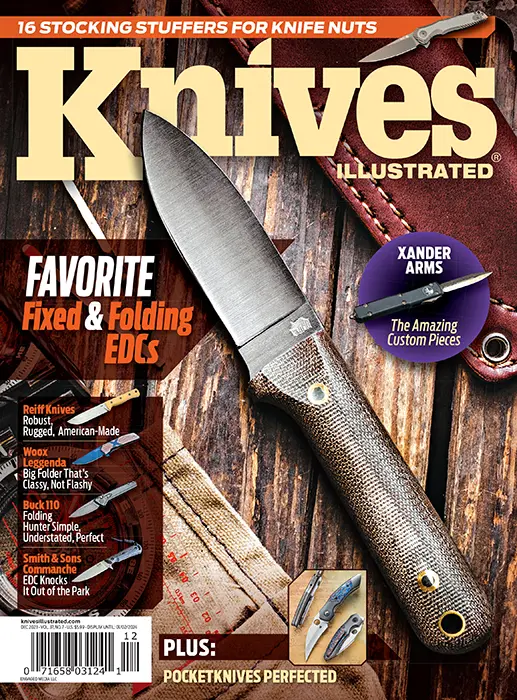 Subscribe / Back Issues
Subscribe / Back Issues